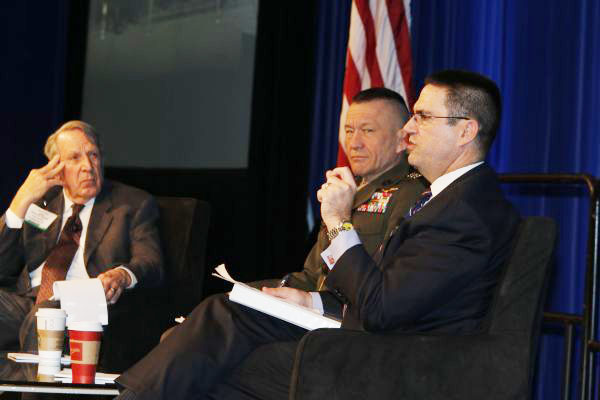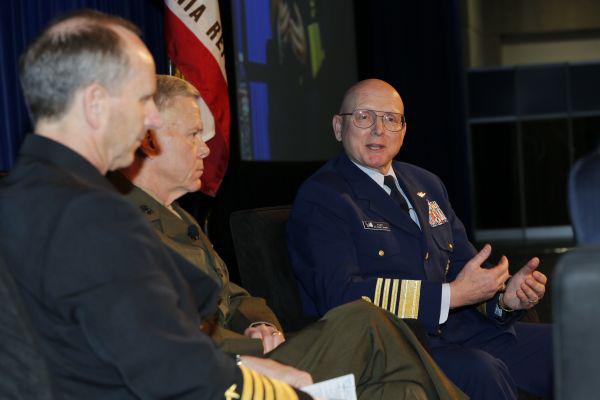Cyber, China Challenges Loom Large for U.S. Military
West 2013 Online Show Daily, Day 3
Quote of the Day: “Make no mistake: the PLAN is focused on war at sea and sinking an opposing fleet.”—Capt. Jim Fanell, USN, deputy chief of staff for intelligence and information operations, U.S. Pacific Fleet
Two separate issues, both on the rise, have become increasing concerns for U.S. military planners. The technology-oriented world of cyber and the geopolitical challenge of a growing Chinese military are dynamic issues that will be major focus points for the U.S. defense community in the foreseeable future.
Cyber security is becoming increasingly complex because of the plethora of new information technologies and capabilities entering the force. Security planners must strike a balance between effectively protecting these new information systems and imposing constraints that would wipe out most of the gains they offer.
China, the world’s rising economic power, is evolving into a military power with a reach that extends increasingly beyond its littoral waters. The U.S. strategic rebalance to the Asia-Pacific region is likely to enmesh U.S. military forces in local issues to a greater degree, and China’s steady growth in military strength will affect how international relations evolve in that vast region.
These were among the points covered in the final day of AFCEA/USNI West 2013 in San Diego. Unlike the first two days, this part of the conference did not focus on the looming budget crisis, although that topic did come into play during some of the sessions. Instead, the event stayed closer to its theme of Pivot to the Pacific.
Cyber is a topic that affects all areas of operation, and the day’s opening fireside chat focused on the challenges facing the Defense Department. Robert J. Carey, deputy chief information officer for the U.S. Defense Department, explained that the new mobile communications devices proliferating throughout all levels of the military pose a new kind of security challenge. They must be secured so that users can access the cloud through them, but the security measures must not remove the advantages they bring to the force.
One approach to enable cloud access would be to tie identity credentials to these devices. “If we can’t do that, then we’ve created more of a problem than an answer,” Carey stated.
The U.S. Cyber Command is training most of its growing ranks to serve in the field, said its deputy commander, Lt. Gen. Jon M. Davis, USMC. That number, which totals about 6,000 people assigned to the command, is likely to rise to 14,000 over the next few years. The cyber force is being trained to serve in units geared toward their assignments and settings.
China’s navy, known as the People’s Liberation Army Navy (PLAN), was the focal point of the day’s only panel. Diverse opinions emerged from among the military officers and academics who composed the panel, but they all agreed that China is extending its power as it aims to become the world’s next superpower.

Panel moderator Vice Adm. Herbert A. Browne, USN (l), listens as panelists (l-r) Lt. Gen. Jon M. Davis, USMC, deputy commander of the U.S. Cyber Command; and Robert J. Carey, deputy chief information officer for the U.S. Defense Department, discuss key cyber issues.
The Middle Kingdom has become increasingly aggressive as its navy reaches farther beyond its littoral waters, and that is having a different effect than the Chinese want. Capt. Jim Fanell, USN, deputy chief of staff for intelligence and information operations, U.S. Pacific Fleet, said that China has taken control of areas outside its borders that never have been administered to, or controlled by, any government of China in recent history. China’s coastal cutters seem to have no other mission than to harass others to submit to its territorial claims. The result is that the countries of East Asia “now remember why they like the United States,” he said.
Capt. Fanell declared that the PLAN has become a very capable fighting force. PLAN maneuvers increasingly are about countering the U.S. Pacific Fleet. “Make no mistake: the PLAN is focused on war at sea and sinking an opposing fleet,” Capt. Fanell stated.
Dr. Toshi Yoshihara, professor and John A. van Beuren chair of Asia-Pacific Studies, Strategy and Policy, Naval War College, said that the key operational challenge is China’s family of land- and sea-based antiship missiles. China has been theorizing about the combined use of different missiles in antiship warfare for more than a decade, he related.
All of the panelists agreed that the PLAN is serving a leading role in Chinese power projection. “The PLAN is at the tip of the Chinese spear,” said David M. Finkelstein, vice president and director, China studies, Center for Naval Analyses.
The budget issue reared its head in the conference’s final presentation; a star-studded luncheon that featured the three sea service chiefs. While the chief of naval operations, the Marine Corps commandant and the Coast Guard commandant began their discussion on the Asia-Pacific region, they ultimately offered their own assessments of what catastrophic budget cuts will do to the force.
Adm. Jonathan W. Greenert, USN, chief of naval operations, described his worries about the sequestration and continuing resolution effects on the industrial base. He fears that deep cuts will push some companies into extinction, and they will take with them vital expertise that cannot be reconstituted.
“Half of the nuclear vendors are single source,” the admiral pointed out. “If they go under, I don’t know how we’ll get them back. How we will recover from that, I don’t know.”
All of the services are faced with diverting funds to address key needs. However, even that may not be a viable short-term solution. Adm. Greenert said that, if the Navy does not obtain the funding along with the ability to reprogram it, ships will not be deployed in time and the fleet will not have the readiness it needs.
And that readiness may extend to entire force-defining capabilities. Gen. James R. Amos, USMC, commandant of the Marine Corps, warned that some people will think that key capabilities are not needed—until they are needed desperately.
“People ask why we need a capability for forced entry [invasion],” he related. “It would be pretty naïve to think that, in the future, there won’t be a time and place when our nation says ‘it’s time to impose our will’ and we need a force to enter a hostile place.” That capability might be lost when it is needed the most, he pointed out.
Gen. Amos left no ambiguities in his assessment of the strategic shift to the Asia-Pacific region. “We need to stay the course with the [rebalancing] strategy,” he declared. “We may like to think that we’re done with the thorny ‘other things’ going on around the world, but they’re not done with us.” His two command counterparts agreed that, whatever budget cuts are imposed on the U.S. military services, the strategic rebalance toward the Asia-Pacific region must be carried out.
Mark your calendar for West 2014, January 14-16 in San Diego.





Comments